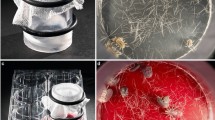Summary
The argasid tick,Ornithodoros moubata porcinus, is a natural reservoir and vector of African swine fever virus. The stability of ASFV in dead ticks was first determined and then laboratory-reared, nymphal ticks were infected by feeding on viraemic domestic pigs; “Uganda” strain virus multiplied and persisted over periods of 13–15 months in 70–75% of ticks. Infected tampans regularly transmitted ASF to domestic pigs, even when fed singly; in only about two-thirds of cases was virus excreted in the coxal fluid. “Tengani” strain virus, however, produced persistent infection in but 5% of ticks, following the ingestion of approximately 104 to 105 HAD50.
The minimum infective dose of 3 strains of ASFV for ticks collected in Uganda, was investigated by the capillary-feeding technique. Some ticks were infected by 100.9 to 101.9 HAD50 of “Uganda” virus and virtually all by doses ⪖ 104.0 HAD50; a recent warthog isolate in a dose of 105.0 HAD50 caused persistent infection in 60% of ticks, whilst 104.0 HAD50 of a tick isolate produced only 40% persistent infections. Some Uganda ticks exhibited virus proliferation of at least 3–4 log10 units and transmitted ASFV to pigs during natural feeding; virus was sometimes excreted in the coxal fluid.
These results were discussed in relation to the maintenance of ASFV and the probable sites of localisation in the tick; ASFV has the essential characteristics of a tick-borne arbovirus.
Similar content being viewed by others
References
Anonymus: Wld. Hlth Org. Tech. Kep. Ser., No. 219 (WHO, Geneva) (1961).
Botija, C. S.: Estudios sobre la peste porcina afrioana en Espagna. Bull. Off. int. Epiz.58, 707–727 (1962).
Botija, C. S.: Reservorios del virus de la peste porcina africana. Investigacion del virus de la P.P.A. en los artropodos mediante la prueba de la hemoadsorcion. Bull. Off. int. Epiz.60, 895–899 (1963).
Botija, C. S.: Present characteristics of African swine fever in Spain. FAO/OIE International Meeting on hog cholera and African swine fever. Rome, Italy. Working Paper No. 15 (1965).
Burgdorfer, W.: Artificial feeding of ixodid ticks for studies on the transmission of disease agents. J. inf. Dis.100, 212–214 (1957).
Burgdorfer, W., andM. G. R. Varma: Trans-stadial and transovarial development of disease agents in arthropods. Ann. Rev. Entomol.12, 347–376 (1967).
Cox, B. F., andW. R. Hess: Note on an African swine fever investigation in Nyasaland. Bull. epiz. Dis. Afr.10, 439–440 (1962).
De Tray, D. E.: African swine fever. Adv. vet. Sci.8, 299–333 (1963).
Howell, C. J.: Collection of salivary gland secretion from the argasidOrnithodoros savigni Adouin (1827) by the use of a pharmacological stimulant. J. S. Afr. vet. med. Assoc.37, 236–239 (1966).
Hurlbut, H. S.: West Nile virus infection in arthropods. Am. J. trop. Med. Hyg.5, 76–85 (1956).
Kaiser, M. N.: Viruses in ticks. II. Experimental transmission of Quaranfil virus. Am. J. trop. Med. Hyg.15, 976–985 (1966).
Malmquist, W. A., andD. Hay: Hemadsorption and cytopathic effect produced by African swine fever virus in swine bone marrow and buffy coat cultures. Am. J. vet. Res.21, 104–108 (1960).
Plowright, W., andJ. Parker: The stability of African swine fever virus with particular reference to heat and pH inaotivation. Arch. ges. Virusforsch.21, 383–402 (1967).
Plowright, W., J. Parker, andM. A. Peirce: African swine fever virus in ticks (Ornithodoros moubata Murray) collected from animal burrows in Tanzania. Nature (Lond.)221, 1071–1073 (1969).
Ploweight, W., J. Parker, andM. A. Peirce: The epizootiology of African swine fever in Africa. Vet. Rec.85, 668–674 (1969).
Scott, G. R.: The virus of African swine fever and its transmission. Bull. Off. int. Epiz.63, 645–677 (1965).
Tatchel, R. J.: A modified method for obtaining tick oral secretion. J. Parasitol.53, 1106–1107 (1967).
Thompson, W. R.: Use of moving averages and interpolation to estimate median effective dose. Bact. Rev.11, 115–145 (1947).
van der Merwe, S.: Some remarks on the “tampans” of theOrnithodoros moubata complex in Southern Africa. Zoolog. Anz.181, 280–289 (1968).
Varma, M. G. R.: Transmission of relapsing fever spirochaetes by ticks. Symp. zool. Soc. Lond., No. 6, pp. 61–82 (1962).
Whitman, L., andT. H. G. Aitken: Potentiality ofO. moubata as a reservoir of West Nile virus. Ann. trop. Med. Parasitol.54, 192–204 (1960).
Author information
Authors and Affiliations
Additional information
Dedicated to Prof. Dr. Dr. C.Hallauer on the occasion of his 70th birthday.
Rights and permissions
About this article
Cite this article
Plowright, W., Perry, C.T., Peirce, M.A. et al. Experimental infection of the argasid tick, ornithodoros moubata porcinus, with African swine fever virus. Archiv f Virusforschung 31, 33–50 (1970). https://doi.org/10.1007/BF01241664
Received:
Issue Date:
DOI: https://doi.org/10.1007/BF01241664




